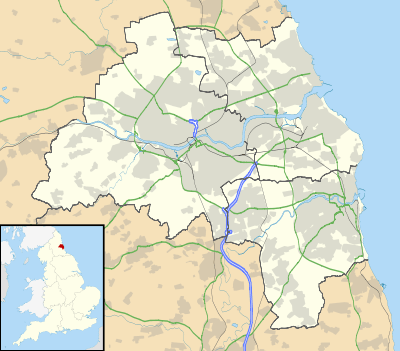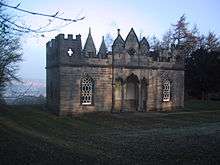Gibside
| Gibside | |
|---|---|
|
The shell of Gibside Hall | |
| Location | England |
| Nearest city | Newcastle upon Tyne |
| Coordinates | 54°55′28″N 1°43′36″W / 54.9245°N 1.7267°WCoordinates: 54°55′28″N 1°43′36″W / 54.9245°N 1.7267°W |
| Built | 1603-1620 |
| Built for | Sir William Blakiston |
| Owner | National Trust |
 Location of Gibside in Tyne and Wear | |
Gibside is an estate in the Derwent Valley in North East England. It is between Rowlands Gill, Tyne and Wear and Burnopfield, County Durham. Gibside was previously owned by the Bowes-Lyon family. It is now a National Trust property. The main house on the estate is now a shell, although the property is most famous for its chapel. The stables, walled garden and Banqueting House are also intact.
History
The Blakiston family acquired the estate by marriage in about 1540. Sir William Blakiston (1562–1641) replaced the old house with a spacious mansion between 1603 and 1620. Both the Royal (King James I of England) coat of arms and the Blakiston coat of arms are seen over the entrance of the old Hall.[1] The Gibside property came into the possession of the Bowes family in 1713; a result of the marriage between Sir William's great granddaughter, Elizabeth Blakiston, to Sir William Bowes (1657–1707) of Streatlam Castle (now demolished) in 1693.[2]
Until 1722,[3] the basis of the Bowes' influence was their own estate and castle of Streatlam. However, after that date the acquisition through marriage of the Blakiston estate gave the Bowes family an even greater influence in the north of the county and a share in the immense wealth that was to be acquired from the coal trade. The Blakiston estate included some of the area's richest coal seams.[4]
In 1767 the granddaughter of Sir William Bowes – the "Bowes heiress" Mary Eleanor Bowes – married John Lyon, 9th Earl of Strathmore and Kinghorne, who changed his surname to Bowes due to a provision in her father's will that any suitor had to take the family name. This was a device to continue the Bowes lineage in the absence of a male heir.
Improvements to Gibside carried out by the Bowes-Lyon family included landscaping in the 18th century, a chapel (Gibside Chapel, built between 1760 and 1812), a banqueting hall, a column of Liberty, an avenue of oaks and several hundred acres of forest.
Gibside's main house is not the focal point of the estate: the long walk runs from the Column of Liberty to the chapel and the mansion is located to one side. The house became vacant in the 1920s after the Bowes-Lyon family sold some of its properties to pay death duties. The building was stripped of its fixtures and fittings, with many of the fireplaces and other items being transferred to Glamis Castle.[5] Parts of the structure were demolished in 1958, including the removal of the roof, the remains are protected by Grade II* listed building status[6] and are included in the Heritage at Risk Register[7]
Parts of the grounds have been designated a Site of Special Scientific Interest, including a forest garden that is currently under restoration. Several buildings including a Palladian chapel and others are awaiting or undergoing restoration.
The chapel and Grand Walk have been in the National Trust's ownership since 1965 and an additional 354 acres (1.43 km2) of the grounds were acquired in 1993. The Banqueting House has been in the ownership of the Landmark Trust since 1981, the building having been restored from a derelict shell. The stables now house a learning and discovery centre.[8]
Land army girls were billeted at Gibside during World War I.[9]
Gallery
- Shell of the Orangerie
- The Stables
 The Banqueting House
The Banqueting House- The Column to Liberty
References
- ↑ "Photo c1932 - Royal (James I) Coat of Arms over Blakiston Coat of Arms. Gibside Hall". Durham County Council. 2009. Retrieved 12 November 2011.
- ↑ A Genealogical and Heraldic History of the Extinct and Dormant Baronetcies of England. Burke's Peerage. 1838. Retrieved 14 October 2012.
- ↑ Historic England. "Gibside Hall (22481)". PastScape. Retrieved 26 October 2013.
- ↑ "Bowes and Strathmores – Gibside and Streatlam". Sunniside Local History Society. Retrieved 21 October 2012.
- ↑ National Heritage List for England, entry for Gibside.
- ↑ National Heritage List for England, entry for Gibside.
- ↑ Heritage at Risk Register entry for Gibside
- ↑ https://www.newcastlegateshead.com/things-to-do/gibside-p23331
- ↑ Historic England. "Gibside Hall, 17th to 19th century country house (1017224)". National Heritage List for England. Retrieved 4 April 2015.
External links
| Wikimedia Commons has media related to Gibside. |